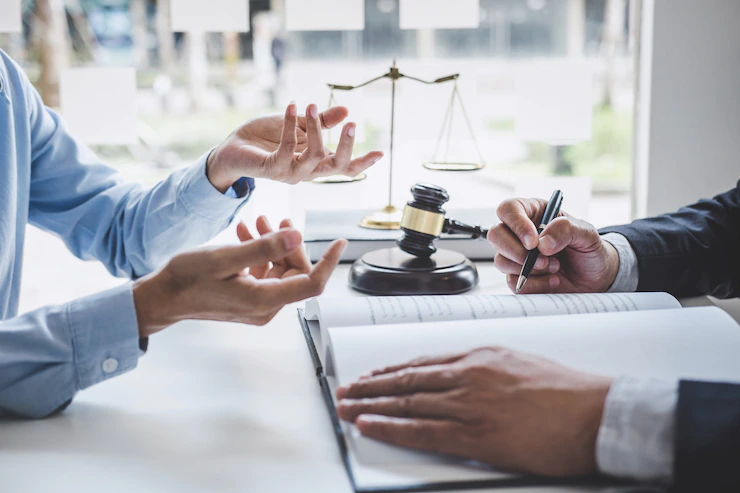How To Determine Fault In Personal Injury Case

Table Of Contents
Once the harm is caused by the negligence of another person or entity, the first step is to seek medical treatment.
After that, you should start collecting evidence concerning the incident and the harm caused by the injury.
There must be some video footage, police reports, photographs, medical documents, bills, insurance modifications, disability claims, and witness and doctor testimony, which could act as evidence to prove who was at fault.
After gathering evidence, the next stage is to decide who is to blame.
Both the plaintiff and the defendant may share blame in personal injury proceedings.
However, if you want to know more about it, you must keep on scrolling down to the end of the post.
How To Determine Fault In A Personal Injury Case?

You can check the Trollinger Law home page to find out how experienced lawyers handle personal injury claims. There are various ways to determine fault in a personal injury case. Let’s check them out here:
#1: Negligence
It will assist clinch a case for culpability, boost damages, or both if the plaintiff and their counsel can establish that the defendant was negligent.
A plaintiff must have the responsibility that requires the actor to follow a specified code of conduct in order to safeguard others.
If you can’t fulfill the mandatory task or responsibility, or the harms were directly related to the defendant’s failure to act, and there was actual loss or harm, it proves someone was at fault.
To establish negligence, each of these components must be established.
Determining negligence is a fact-intensive process that varies from case to case. Since finding negligence is not easy, it requires the assistance of an experienced attorney who is familiar with the relevant case law.
#2: Strict Liability
All items, especially those that are intrinsically harmful, must be properly prepared, packaged, and labelled by businesses.
If a product, container, or label causes harm or death to a person, the firm may be held accountable for any damages produced by their product.
#3: Willful Misconduct
Willful wrongdoing is frequently used by persons or companies that are normally immune from civil action if they behave in good faith.
Charitable groups and emergency personnel are two examples. However, these people can also be at fault, and if you have proper evidence to prove it, you may win the claim.
What Should Be Your Common Defence In A Personal Injury Case?

No matter how strong your evidence is, the other party will also have a strong defence strategy to nullify your claim or reduce your compensation amount. Let’s have a look:
(i). Comparative Fault
In a comparative fault situation, both parties are responsible for the mishap. Throughout the case, the court will evaluate how much each party was to blame for the injuries.
The legal basis for this is that persons must be accountable for their own basic premise of safety at all times. More than often, people proved that the wounded individual may have contributed to the harm in some way.
Even if you have all the proof you need, the opposing party will deploy defences to limit or eliminate your rightful recompense.
Claims for comparative culpability, acceptance of risk, employer responsibility, and trespass are examples.
(ii). Employer Liability
Employers might have held accountable for their workers’ behaviour if the employer was aware that the employee had harmful tendencies.
If the people have expectation to injuries to the plaintiff, or the conduct took place then it also makes the employer liable. In this case he/she has to compensate the employee.
The company had several opportunities to terminate. Or have the employee arrested for the burglaries but chose not to do so. Employers may try to downplay their prior knowledge of a risky employee or provide proof. Therefore, they took adequate steps to resolve any difficulties.
(iii). Risk Assumption
A defendant must establish three elements to defeat a personal injury claim utilising this defence:
- The plaintiff was aware of the danger.
- He recognized the danger.
- He voluntarily exposed himself to it.
Defendants may attempt to make it appear that the plaintiff had more knowledge than they did or that their acts were more overt than they were. To counter this response, you’ll need to use a three-pronged approach to show that the assertion is false.
(iv). Trespass
There are various methods to be awarded damages for trespass under O.C.G.A. 51-11-9.
The first is the most evident because it entails physically entering someone’s property. Any harm experienced when trespassing is usually not covered by insurance.
However, if someone uses unjustified, lethal force to evict someone from the property, they may be entitled to sue for damages because unjustified force is not covered by the castle concept.
Why Should You Hire A Personal Injury Lawyer?

You will have a difficult time proving the defendant’s fault in the accident for the damage that has occurred if you do not engage a top personal injury lawyer with a track record of success.
Evidence can be deliberately or accidentally destroyed. Important aspects in your arguments may be overlooked or underused. Even worse, a defendant might attack you or a loved one when you are in distress.
Trollinger Law Firm can help you every step of the process, as they have done for dozens of previous customers. Allow Trollinger Law Firm to handle your legal dispute so you can concentrate on what matters most: your family and your recovery.
Bonus Tip!
When more than one person is at fault for an accident, most states’ laws require that any of the negligent parties compensate you completely for your injuries. The relevant parties must next decide whether or not they should repay each other.
This guideline of collecting from any responsible individual offers you a number of significant benefits.
If one of the culpable parties is insured, but the other is not, you can file a claim for the full amount against the covered party. Even if both are covered, you will only have to deal with one insurance provider to resolve your claim.
To begin, think of everyone you suspect is to blame and inform them that you may make a claim for damages.
For further queries, reach us in the comment box below.
Read Also:

























